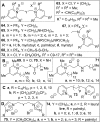Transfection by cationic gemini lipids and surfactants
- PMID: 30288217
- PMCID: PMC6148748
- DOI: 10.1039/c8md00249e
Transfection by cationic gemini lipids and surfactants
Abstract
Diseases that are linked to defective genes or mutations can in principle be cured by gene therapy, in which damaged or absent genes are either repaired or replaced by new DNA in the nucleus of the cell. Related to this, disorders associated with elevated protein expression levels can be treated by RNA interference via the delivery of siRNA to the cytoplasm of cells. Polynucleotides can be brought into cells by viruses, but this is not without risk for the patient. Alternatively, DNA and RNA can be delivered by transfection, i.e. by non-viral vector systems such as cationic surfactants, which are also referred to as cationic lipids. In this review, recent progress on cationic lipids as transfection vectors will be discussed, with special emphasis on geminis, surfactants with 2 head groups and 2 tails connected by a spacer.
Figures


















References
Publication types
LinkOut - more resources
Full Text Sources
Other Literature Sources

